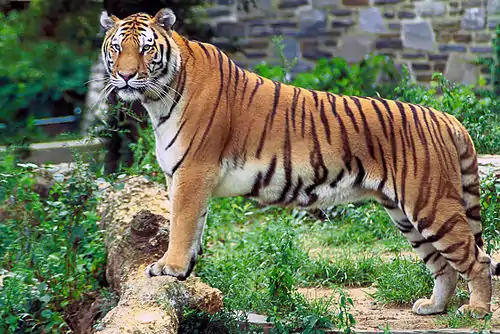< Wikijunior:Big Cats
 |
| Wild Cats |
|
Introduction |
A glossary of terms used in this book:
- Canine teeth: Sometimes called fangs, they are teeth used as weapons and to grasp and hold prey.
- Captivity: When animals are kept by humans.
- Carnivore: An animal that eats meat.
- Carrion: The flesh of a dead animal, which is eaten by carnivores or scavengers.
- Classification: The way scientists give animals names that everyone around the world will understand, in a way that reflects our scientific understanding of how closely different animals are related to one another.
- Conservation: Ways of reducing the amount of natural resources used, including reusing and recycling.
- Diurnal: Active during the day and asleep at night.
- Domestication: Taking animals from their natural habitat into the human habitat, then changing them in ways that make them more suitable to living with humans.
- Endangered: Animals that are in danger of becoming extinct.
- Extinction: When all animals of a kind are gone, that kind of animal is extinct. They can never come back.
- Family: A medium sized group used in classification, it is made up of very closely related animals.
- Fertile: Able to have offspring.
- Flank: The side part of an animal's body.
- Habitat: An area able to support a type of animal.
- Herbivore: An animal that eats plants such as leaves and berries.
- Hybrid: The offspring of two animals of different but similar kinds, such as a lion and a tiger.
- Hybridization: When two animals of different kinds have offspring together.
- Instinct: An animal's inherited knowledge; knowledge that did not have to be learned.
- Jungle: A large forest in warm countries with many different kinds of animals and plants. Also called a rainforest.
- Life span: How long an animal usually lives.
- Litter: A group of baby mammals with the same parents.
- Mammal: A warm-blooded animal that has hair on its skin and gives its young milk to drink.
- Mane: The furry crown around a male Lion's head.
- Muzzle: The part of an animal's face that includes the nose and jaws.
- National Park: Land that is kept in a natural state for a variety of reasons, all of them important.
- Nature preserve: Land that is kept in a natural state for conservation reasons where the welfare of plants and animals is more important than any other uses.
- New World: North, Central and South America.
- Nocturnal: Active at night and asleep during the day.
- Offspring: The children of an animal.
- Old World: Europe, Asia, Australia and Africa.
- Order: A very large group used in classification, it contains a number of closely related families.
- Poaching: Illegally killing an animal.
- Prairie: A large, flat plain with a lot of grass and almost no trees, such as the Great Plains of North America.
- Predator: An animal that hunts other animals and eats them.
- Prey: An animal hunted by another animal for food.
- Rainforest: A large forest that stays warm and wet year round with many different kinds of animals and plants. Also called a jungle.
- Rosette: A mark in an animal's fur where a number of closely placed spots form an unbroken circle.
- Retract (claw): The hiding of claws inside a paw.
- Savannah: A large, flat plain with a lot of grass and scattered groups of trees, such as in East Central Africa.
- Scavenge: To look for meat for food that was killed by a different animal.
- Scientific name: The name given to a species by scientists when they classify it.
- Siblings: All the offspring from one litter, or sometimes offspring with the same parents from two different litters.
- Species: A group of animals that under normal conditions can have offspring together.
- Steppes: A large, flat plain with a lot of grass and almost no trees.
- Sterile: Not able to have children.
- Subtropical: An area that never gets very cold in the winter, but which has different seasons.
- Tropical: An area that never gets cold and does not have different seasons. Tropical areas are found close to the equator, and on a world map the area between the Tropic of Capricorn and Tropic of Cancer is considered the tropics.
- Wildlife refuge: Land that is used to protect of wild animals. Sometimes parts of a wildlife refuge are not kept in a natural state to give certain species of animals a little extra help. Planting rice in a water bird area is one example.
- Zoo: A type of living museum where animals are kept for people to learn about them and have fun.
This article is issued from Wikibooks. The text is licensed under Creative Commons - Attribution - Sharealike. Additional terms may apply for the media files.